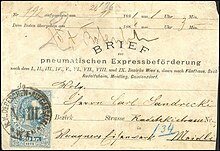Pneumatic post in Vienna
In Austria the Austrian Post and Telegraph Administration (today: Österreichische Post AG ) operated a pneumatic tube network only in Vienna and from March 4, 1899 in Prague . The Viennese network reached its greatest expansion with 53 post offices and 82.5 km of pipe length and was discontinued in 1956 due to the inefficiency of modern telecommunications services.
In Graz, the main post office building at Neutorgasse 46 was connected to the telegraph office, 150 m as the crow flies, at Andreas-Hofer-Platz 19 - built in 1927/31 - by a pneumatic tube system that crossed under Kalchberggasse and whose post office was still there in 1995 was. Around 2005/2010 it was dismantled in the course of renovations. With this system, the telegram cards were sent to the post office on Neutorgasse.
Monarchy and Republic until 1938
In Vienna, the first pneumatic post systems went into operation on February 15, 1875, initially only for telegrams ( dispatches ) and express mail. The carriage of letters was possible from March 1, 1875, as stated in the ordinances for the Austrian telegraph offices , issue No. 3 of March 19, 1875. At the beginning, ten post offices (all within today's belt border ) were set up at intervals of 1 connected with pipelines up to 3 km. The pneumatic tube network was 14 kilometers long, of which 2.2 kilometers were used to supply compressed or diluted air to two storage facilities in the Laurenzer building on the meat market . The system grew steadily, so that in 1913 there were already 53 post offices with a pipe length of 82.5 km. In 1902 the pneumatic tube was equipped with new compressors from Hanns Hörbiger .
At peak times, up to 20,000 cylinders (cans) were sent through the pipes under the city as pneumatic tube trains, each with a maximum of 15 cans. The pneumatic tube trains reached a speed of almost 50 km / h.
A pneumatic tube station from Vienna with visible tubes made of brass is exhibited in the Technical Museum Vienna .
Period during National Socialism 1938–1945
During the National Socialist era of Austria ( Ostmark ), from March 1938 to April 1945, the same conditions applied to pneumatic tubes in Vienna as to pneumatic tubes in Berlin and Munich . A special feature is the period from April 4 to October 31, 1938, when old postage stamps from the Republic of Austria were still valid, also in combination with postage stamps from the German Reich.
Republic of Austria from April 26, 1945
During the Second World War , the pneumatic tube system was badly damaged (only 7% was still usable), but it was put back into operation very quickly. But she could never reach the pre-war promotion figures again. In 1950 it came to only 5500 transmissions per day, i. H. on less than 2 million shipments per year. Given the length of Vienna's pneumatic tube network, this was not enough. On April 2, 1956, the post office stopped operating the pneumatic tube system in Vienna due to falling transport numbers and the increase in telephone coverage for the population. Regardless of this, the pneumatic tube system was still used decades later for the fast dispatch of incoming express deliveries, etc., as shown by stamps on the back of the corresponding mail.
Non-public use
Today - before the planned renovation from 2017 - the Austrian parliament building on the Ring still has its own pneumatic tube system, which also connects the surrounding buildings on Reichsratsstrasse , which belong to the parliamentary administration.
The Kaiser Franz Josef Hospital in Vienna was in 2016 to install a pneumatic tube system new, to transport blood samples to the laboratory. The supplier is the Viennese industrial and building technology company Sumetzberger, for which pneumatic tube systems became the main division and which, for example, supports 167 hospitals in China with pneumatic tubes. The samples are marked with barcode labels, are held in the can and must not be shaken too vigorously, which is why they only travel at 5–6 m / s. Particularly urgent shipments, such as tissue samples from ongoing cancer operations, are prioritized in the pipe run and can therefore overtake less urgent matters.
Today in-house pneumatic tube systems are built almost exclusively. For example, to safely transport money from department store tills or road toll booths, tools in industrial plants or samples from the ongoing production of steel and cement works. In Vienna alone, Sumetzberger names more than 30 clients for systems, including banks, universities, office and event buildings, hotels, schools and freight forwarders.
Many years ago Sumetzberger suggested reactivating the Viennese pneumatic tube post, especially between the West and South train stations, but got a rejection with reference to the high costs of road excavations.
Bibliography and sources
- History of the Austrian Post AG
- Article in Vienna Online
- BUISPOST.EU Many pictures of pneumatic post stamps and envelopes from Vienna.
Individual evidence
- ↑ http://www.grazerbe.at/index.php?title=Andreas-Hofer-Platz_19 Bauerbe in Graz, Grazwiki, all addresses> Andreas-Hofer-Platz 19, accessed March 25, 2013
- ^ The pneumatic post. In: Morgen-Post , No. 52/1875 (XXV. Volume), February 21, 1875, p. 2 f. (unpaginated). (Online at ANNO ). .
- ↑ Gerhard Fürnweger: history and stories. Pneumatic post in Vienna 1875–1956 , accessed on November 6, 2016.
- ↑ http://www.parlament.gv.at/GEBF/ARGE/Baugeschichte/Autarkie/ parlament.gv.at Autarkie
- ↑ Petra Fleck: Comeback of an old technology: Main area of application in hospitals orf.at, November 6, 2016, accessed November 6, 2016.
